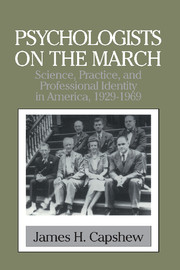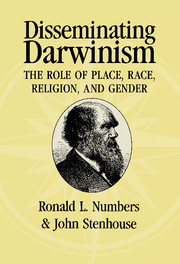Refine search
Actions for selected content:
13588 results in History of science and technology

Resistance to New Technology
- Nuclear Power, Information Technology and Biotechnology
-
- Published online:
- 06 July 2010
- Print publication:
- 22 June 1995

Psychologists on the March
- Science, Practice, and Professional Identity in America, 1929–1969
-
- Published online:
- 06 July 2010
- Print publication:
- 13 January 1999

Disseminating Darwinism
- The Role of Place, Race, Religion, and Gender
-
- Published online:
- 06 July 2010
- Print publication:
- 28 December 1999
Linnaeans outdoors: the transformative role of studying nature ‘on the move’ and outside
-
- Journal:
- The British Journal for the History of Science / Volume 44 / Issue 2 / June 2011
- Published online by Cambridge University Press:
- 14 June 2010, pp. 183-209
- Print publication:
- June 2011
-
- Article
- Export citation
Science as an ally of religion: a Muslim appropriation of ‘the conflict thesis’
-
- Journal:
- The British Journal for the History of Science / Volume 44 / Issue 2 / June 2011
- Published online by Cambridge University Press:
- 14 June 2010, pp. 161-181
- Print publication:
- June 2011
-
- Article
- Export citation
Kristin C. Harper, Weather by the Numbers: The Genesis of Modern Meteorology. Cambridge, MA and London: MIT Press, 2008. Pp. xii+308. ISBN 978-0-262-08378-2. £25.95 (hardback).
-
- Journal:
- The British Journal for the History of Science / Volume 43 / Issue 2 / June 2010
- Published online by Cambridge University Press:
- 14 June 2010, pp. 314-315
- Print publication:
- June 2010
-
- Article
- Export citation
J.F.M. Clark, Bugs and the Victorians. New Haven and London: Yale University Press, 2009. Pp. xiii+322. ISBN 978-0-300-15091. £25.00 (hardback).
-
- Journal:
- The British Journal for the History of Science / Volume 43 / Issue 2 / June 2010
- Published online by Cambridge University Press:
- 14 June 2010, pp. 310-311
- Print publication:
- June 2010
-
- Article
- Export citation
Aitor Anduaga, Wireless and Empire: Geopolitics, Radio Industry and Ionosphere in the British Empire, 1918–1939. Oxford: Oxford University Press, 2009. Pp. xxv+386. ISBN 978-0-19-956272-5. £39.95 (hardback).
-
- Journal:
- The British Journal for the History of Science / Volume 43 / Issue 2 / June 2010
- Published online by Cambridge University Press:
- 14 June 2010, pp. 312-314
- Print publication:
- June 2010
-
- Article
- Export citation
Ruth Schwartz Cowan, Heredity and Hope: The Case for Genetic Screening. Cambridge, MA and London: Harvard University Press, 2008. Pp. 292. ISBN 978-0-674-02424-3. £20.95 (hardback). - S. Peter Harper, A Short History of Medical Genetics. Oxford: Oxford University Press, 2008. Pp. ix+557. ISBN 978-0-19-518750-2. £22.99 (hardback).
-
- Journal:
- The British Journal for the History of Science / Volume 43 / Issue 2 / June 2010
- Published online by Cambridge University Press:
- 14 June 2010, pp. 317-319
- Print publication:
- June 2010
-
- Article
- Export citation
David Knight, The Making of Modern Science: Science, Technology, Medicine, and Modernity, 1789–1914. Cambridge and Malden, MA: Polity, 2009. Pp. xiv+370. ISBN 978-0-7456-3676-4. £17.99 (paperback).
-
- Journal:
- The British Journal for the History of Science / Volume 43 / Issue 2 / June 2010
- Published online by Cambridge University Press:
- 14 June 2010, pp. 301-302
- Print publication:
- June 2010
-
- Article
- Export citation
Charles Webster, Paracelsus: Medicine, Magic and Mission at the End of Time. New Haven and London: Yale University Press, 2008. Pp. xiv+326. ISBN 978-0-300-13911-2. £30.00 (hardback).
-
- Journal:
- The British Journal for the History of Science / Volume 43 / Issue 2 / June 2010
- Published online by Cambridge University Press:
- 14 June 2010, pp. 292-295
- Print publication:
- June 2010
-
- Article
- Export citation
Eleanor Robson and Jacqueline Stedall (eds.), The Oxford Handbook of the History of Mathematics. Oxford: Oxford University Press, 2009. Pp. vii+918. ISBN 978-19-921312-2. £85.00 (hardback).
-
- Journal:
- The British Journal for the History of Science / Volume 43 / Issue 2 / June 2010
- Published online by Cambridge University Press:
- 14 June 2010, pp. 289-291
- Print publication:
- June 2010
-
- Article
- Export citation
Tony Volpe, Science et théologie dans les débats savants de la seconde moitié du XVIIe siècle: La Genèse dans les Philosophical Transactions et le Journal des savants(1665–1710). Preface by Louis Châtellier. Bibliothèque de l'Ecole des Hautes Etudes Sciences Religieuses, 133. Turnhout: Brepols Publishers, 2008. Pp. 467. ISBN 978-2-503-52584-6. €65.00 (paperback).
-
- Journal:
- The British Journal for the History of Science / Volume 43 / Issue 2 / June 2010
- Published online by Cambridge University Press:
- 14 June 2010, pp. 296-297
- Print publication:
- June 2010
-
- Article
- Export citation
Books received
-
- Journal:
- The British Journal for the History of Science / Volume 43 / Issue 2 / June 2010
- Published online by Cambridge University Press:
- 14 June 2010, pp. 323-325
- Print publication:
- June 2010
-
- Article
- Export citation
Matthew D. Eddy, The Language of Mineralogy: John Walker, Chemistry and the Edinburgh Medical School, 1750–1800. Aldershot: Ashgate, 2008. Pp. xxi+309. ISBN 978-0-7546-6332-4. £60.00 (hardback).
-
- Journal:
- The British Journal for the History of Science / Volume 43 / Issue 2 / June 2010
- Published online by Cambridge University Press:
- 14 June 2010, pp. 299-301
- Print publication:
- June 2010
-
- Article
- Export citation
Kurt Ballstadt, Diderot: Natural Philosopher. Oxford: Voltaire Foundation, 2008. Pp. viii+246. ISBN 978-0-72948-3. £55.00 (paperback).
-
- Journal:
- The British Journal for the History of Science / Volume 43 / Issue 2 / June 2010
- Published online by Cambridge University Press:
- 14 June 2010, pp. 297-299
- Print publication:
- June 2010
-
- Article
- Export citation
Faidra Papanelopoulu, Agustí Nieto-Galan and Enrique Perdiguero (eds.), Popularizing Science and Technology in the European Periphery, 1820–2000. Aldershot: Ashgate, 2009. Pp. xviii+284. ISBN 978-7546-6269-3. £60.00 (hardback).
-
- Journal:
- The British Journal for the History of Science / Volume 43 / Issue 2 / June 2010
- Published online by Cambridge University Press:
- 14 June 2010, pp. 311-312
- Print publication:
- June 2010
-
- Article
- Export citation
Eleanor Robson, Mathematics in Ancient Iraq: A Social History. Princeton and Oxford: Princeton University Press, 2008. Pp. xxvii+441. ISBN 978-0-691-09182-2. £35.00 (hardback).
-
- Journal:
- The British Journal for the History of Science / Volume 43 / Issue 2 / June 2010
- Published online by Cambridge University Press:
- 14 June 2010, pp. 286-288
- Print publication:
- June 2010
-
- Article
- Export citation
Philip J. Pauly, Fruits and Plains: The Horticultural Transformation of America. Cambridge, MA and London: Harvard University Press, 2008. Pp. xi+336, ISBN 978-0-674-02663-6. £29.95 (hardback). - Alan L. Olmstead and Paul W. Rhode, Creating Abundance: Biological Innovation and American Agricultural Development. Cambridge: Cambridge University Press, 2009. Pp. xii+467. ISBN 978-0-521-67387-7. £15.99 (paperback).
-
- Journal:
- The British Journal for the History of Science / Volume 43 / Issue 2 / June 2010
- Published online by Cambridge University Press:
- 14 June 2010, pp. 308-309
- Print publication:
- June 2010
-
- Article
- Export citation
Peter M.J. Hess and Paul L. Allen, Catholicism and Science. Westport, CT: Greenwood Press, 2008. Pp. xxvi+241. ISBN 978-0-313-33190-9. $65.00 (hardback). - Don O'Leary, Roman Catholicism and Modern Science: A History. London and New York: Continuum, 2006. Pp. xx+356. ISBN 0-8264-1868-6. £18.99 (hardback).
-
- Journal:
- The British Journal for the History of Science / Volume 43 / Issue 2 / June 2010
- Published online by Cambridge University Press:
- 14 June 2010, pp. 295-296
- Print publication:
- June 2010
-
- Article
- Export citation
